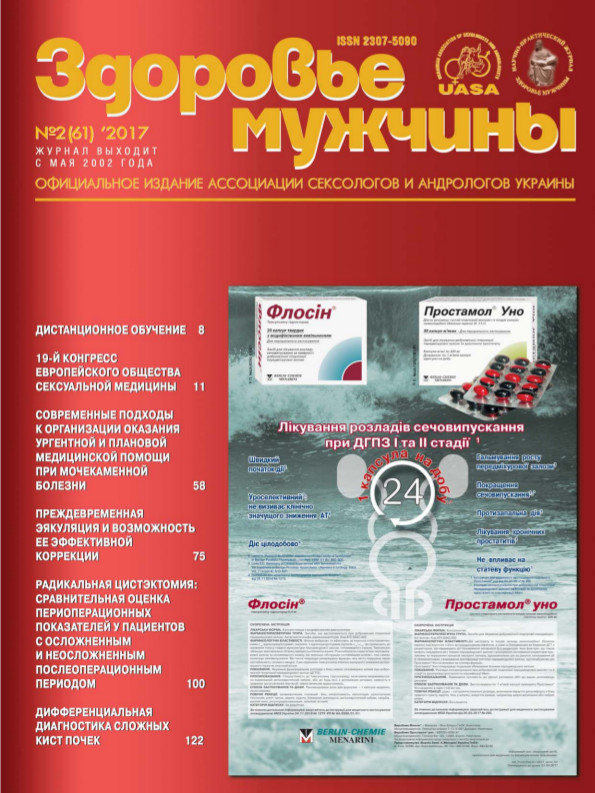Specificities of psychoemotional state of wounded with gunshot damages of upper extremities
##plugins.themes.bootstrap3.article.main##
Abstract
Materials and methods. The study presents preliminary data of a comprehensive survey of 70 wounded with a gunshot injury to the upper limbs that were surgically treated at the Institute of Traumatology and Orthopedics of the National Academy of Medical Sciences of Ukraine and in the traumatology department of the Damage Clinic of the National Military Medical Clinical Center «GVCG» of the Ukrainian Defense Ministry from 2014 to 2017 All victims are men of the most active working age, and half of them are young people under 30 years old. The peculiarity of the work was manifested in the methodical approach, when the realization of the goal required a sociological study. It was carried out through a survey involving well-known, well-proven in clinical practice questionnaires, scales aimed at identifying the psychoemotional state of the contingent.
When processing the results, known classical methods of variational statistics are involved. The degree of accuracy and reliability of the sample statistical values were the mean values and the average errors were calculated. To assess the significance of the differences between the two values, the Student's test was used.
Results. The results of the research show that a high level of personal anxiety was found in practically every fifth (21.4±1.2%) of the interrogated, the average level in half of the patients, which can be manifested by the state of anxiety in various situations, especially in cases that directly concern them . Only in 24.3% of respondents the level of anxiety was determined as optimal and was perceived as an indispensable condition for active human activity.
The overwhelming majority of the wounded (84.3±0.6%) subjectively acknowledged the high level of situational anxiety, manifested by considerable stress, nervousness, anxiety of the threat associated with the physical component of the quality of life. According to respondents' answers, 72.9% of them show firmness of intentions, realism of views, developed sense of personal duty, calmness and confidence, others show uncertainty, emotional instability in intentions, impulsiveness, understated general activity. In 91.4% of cases, the wounded seek to implement planned activities, tasks. However, only 50% of the wounded know themselves in different situations, while the other 50% are spontaneous and impulsive, prone to intense feelings and internal conflicts.
Conclusion. The expediency of studying the self-assessment of the psychoemotional state of the wounded has been proved, the frequency of the need for its correction has been found, including the involvement of a psychotherapist, the need to take into account the character of the individual in all cases in the choice of treatment tactics, especially in multi-stage reconstructive-restorative interventions and the development of an individual rehabilitation program for patients With a traumatic injury of the upper limbs.
##plugins.themes.bootstrap3.article.details##

This work is licensed under a Creative Commons Attribution 4.0 International License.
Authors retain the copyright and grant the journal the first publication of original scientific articles under the Creative Commons Attribution 4.0 International License, which allows others to distribute work with acknowledgment of authorship and first publication in this journal.
References
Карвасарский Б.Д. Психотерапия: учебник / Под ред Б.Д. Карвасарского. – Санкт Петербург, 2007. – 672 с.
Кукурекин Ю.В. Тревожно-депрессивные расстройства и их коррекция / Ю.В. Кукурекин, Л.М. Савенко, Н.В. Свиридова, А.Н. Бушученко // Здоровье мужчины. – 2011. – No 3 (38). – С. 24–26.
Малкина-Пых И.Г. Психосоматика / И.Г. Малкина-Пых. – М.: Эскимо, 2008. – 1024 с.
Менделевич В.Д. Клиническая и медицинская психология / В.Д. Менделевич. – М.: Мед Пресс, 2001. – 458 с.
Невідкладна військова хірургія / пер. з англ. А. Кордіяк. – К.: Наш формат, 2015. – 568 с.
Осипова А.А. Общая психокоррекция. Учебное пособие / А.А. Осипова. – М.: Сфера, 2002. – 510 с.
Пішель В.Я. Стратегії лікування хворих з депресивними розладами: реальна вітчизняна практика та міжнародні стандарти / В.Я. Пішель, І.А. Марценковський, Ф.О. Здорик, Н.О. Дзеружинська [та ін.] // Архів психіатрії. – 2004. – No 2 (37). – С. 125–130.
Политравма: хирургия, травматология, анестезиология, интенсивная терапия. Учебное издание / Под ред. Ф.С. Глумчера, П.Д. Фомина, Е.Г. Педаченко [и др.]. – К.: ВСИ Медицина, 2012. – 736 с.
Юнак В.Ю. Депрессия / В.Ю. Юнак. – К.: Здоров’я, 2012. – 256 с.
Jansen J.O. Selective non-operative management of abdominal gunshot wounds: survey of practise / J.O. Jansen, K. Inaba, S. Resnick [et al.] // J. Injury. – 2013. – V. 44 (5). – P. 639–44.
Soreide K. Epidemiology of major trauma / K. Soreide // Br. J. Surg. – 2009. – V. 96 (7). – P. 697–699.
Traian M.G. Stress: from symptom to disease / M.G. Traian, A.E. Coman, E. Popa, L. Traian, R. Petrovanu [et al.] // Rev Med Chir Soc Med Nat Iasi. – 2013. – V. 117 (1). – P. 72–7.





